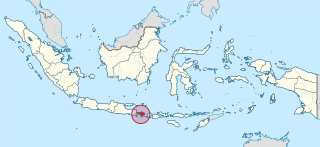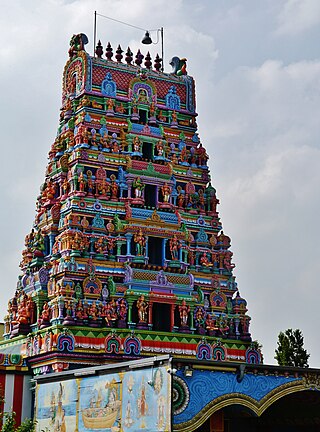
Bali is a province of Indonesia and the westernmost of the Lesser Sunda Islands. East of Java and west of Lombok, the province includes the island of Bali and a few smaller offshore islands, notably Nusa Penida, Nusa Lembongan, and Nusa Ceningan to the southeast. The provincial capital, Denpasar, is the most populous city in the Lesser Sunda Islands and the second-largest, after Makassar, in Eastern Indonesia. The upland town of Ubud in Greater Denpasar is considered Bali's cultural centre. The province is Indonesia's main tourist destination, with a significant rise in tourism since the 1980s. Tourism-related business makes up 80% of its economy.

Dili is the capital and largest city of East Timor. It lies on the northern coast of the island of Timor, in a small area of flat land hemmed in by mountains. The climate is tropical, with distinct wet and dry seasons. The city has served as the economic hub and chief port of what is now East Timor since its designation as the capital of Portuguese Timor in 1769. It also serves as the capital of the Dili Municipality, which includes some rural subdivisions in addition to the urban ones which make up the city itself. Dili's growing population is relatively youthful, being mostly of working age. The local language is Tetum, however residents include many internal migrants from other areas of the country.

Hinduism in Southeast Asia had a profound impact on the region's cultural development and its history. As the Indic scripts were introduced from India, people of Southeast Asia entered the historical period by producing their earliest inscriptions around the 1st to 5th century CE. Today, Hindus in Southeast Asia are mainly Overseas Indians and Balinese. There are also Javanese and Balamon Cham minority in Cambodia and south central Vietnam who also practice Hinduism.

Balibo is a town in East Timor situated approximately 10 kilometres from the Indonesian border. It is located in the sub-district of Balibo, Bobonaro District.

Balinese Hinduism is the form of Hinduism practised by the majority of the population of Bali. This is particularly associated with the Balinese people residing on the island, and represents a distinct form of Hindu worship incorporating local animism, ancestor worship or Pitru Paksha, and reverence for Buddhist saints or Bodhisattava.

Hinduism has historically been a major religious and cultural influence in Java, Indonesia. Hinduism was the dominant religion in the region before the arrival of Islam. In recent years, it has also been enjoying something of a resurgence, particularly in the eastern part of the island.

The Balinese people are an Austronesian ethnic group native to the Indonesian island of Bali. The Balinese population of 4.2 million live mostly on the island of Bali, making up 89% of the island's population. There are also significant populations on the island of Lombok and in the easternmost regions of Java.

Hinduism is the third-largest religion in Indonesia, based on civil registration data in 2022 from Ministry of Home Affairs, is practised by about 1.69% of the total population, and almost 87% of the population in Bali. Hinduism was the dominant religion in the country before the arrival of Islam and is one of the six official religions of Indonesia today. Hinduism came to Indonesia in the 1st-century through Indian traders, sailors, scholars and priests. A syncretic fusion of pre-existing Javanese folk religion, culture and Hindu ideas, that from the 6th-century also synthesized Buddhist ideas as well, evolved as the Indonesian version of Hinduism. These ideas continued to develop during the Srivijaya and Majapahit empires. About 1400 CE, these kingdoms were introduced to Islam from coast-based Muslim traders, and thereafter Hinduism, which was previously the dominant religion in the region, mostly vanished from many of the islands of Indonesia.

Besakih Temple is a pura complex in the village of Besakih on the slopes of Mount Agung in eastern Bali, Indonesia. It is the most important, largest, and holiest temple of Balinese Hinduism, and one of a series of Balinese temples. Perched nearly 1000 meters up the side of Gunung Agung, it is an extensive complex of 23 separate but related temples with the largest and most important being Pura Penataran Agung. The temple is built on six levels, terraced up the slope. The entrance is marked by a candi bentar, and beyond it, the Kori Agung is the gateway to the second courtyard.

Hinduism is the fourth-largest religion in Germany. It is practised by around 0.1% of the population of Germany. As of 2017, there were approximately 130,000 Hindus living in the country.

Hinduism is a minority religion in Belgium. According to the PEW 2014, Hinduism is also the fastest growing religion in Belgium. Attempts have been done by the Hindu Forum of Belgium (HFB) to make Hinduism an officially-recognized religion in Belgium.

Tirta Empul temple is a Hindu Balinese water temple located near the town of Tampaksiring, Bali, Indonesia. The temple compound consists of a petirtaan or bathing structure, famous for its holy spring water, where Balinese Hindus go to for a ritual purification called Melukat. The temple pond has a spring which gives out fresh water regularly, which Balinese Hindus consider to be holy or amritha. Tirta Empul means Holy Spring in Balinese.

A Pura is a Balinese Hindu temple, and the place of worship for adherents of Balinese Hinduism in Indonesia. Puras are built following rules, style, guidance, and rituals found in Balinese architecture. Most puras are found on the island of Bali, where Hinduism is the predominant religion; however many puras exist in other parts of Indonesia where significant numbers of Balinese people reside. Mother Temple of Besakih is the most important, largest, and holiest temple in Bali. Many Puras have been built in Bali, leading it to be titled "the Island of a Thousand Puras".

An Odalan is a Balinese village temple festival in Indonesia. It is an occasion when the Hindu village community comes together, invite the gods to visit them for three or more days, perform religious services together offering refreshments and entertainment. It is a periodic event, one that celebrates Balinese Hindu heritage and performance arts. The Odalan celebrations are a social occasion among Indonesian Hindus, and have historically contributed to the rich tradition of theatre and Balinese dance forms.

Pura ParahyanganAgung Jagatkarta or often referred to simply as Pura Parahyangan is a Hindu temple of Nusantara located in Ciapus village, Tamansari subdistrict, Bogor Regency, West Java, Indonesia.

Pura Girinatha is the largest Balinese Hindu temple in East Timor. It is located in the quarter Taibesi, in the south of the capital city of Dili, near the local market. The temple is located on a small hill outside the city center, but is accessible by car.

Pura Goa Lawah is a Balinese Hindu temple or a pura located in Klungkung, Bali, Indonesia. Pura Goa Lawah is often included among the Sad Kahyangan Jagad, or the "six sanctuaries of the world", the six holiest places of worship on Bali. Pura Goa Lawah is noted for built around a cave opening which is inhabited by bats, hence its name, the Goa Lawah or "bat cave".
Pura Dalem Sakenan is a pura located at the north-western shore of Serangan, a small island about 10 kilometres (6.2 mi) south of Denpasar, Bali. Pura Dalem Sakenan is dedicated to [rambut sedhana] and is associated with prosperity. Pura Dalem Sakenan is the focus temple of the 210-day Piodalan festival where in the past processions of pilgrims visited the island on foot or by traditional colorful wooden boats called jukung. With the construction of the bridge connecting the Serangan island with Bali as well as the reclamation of the island, the use of colorful jukung for pilgrimage has died out.



















